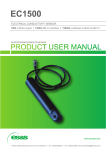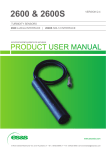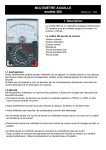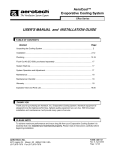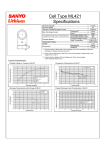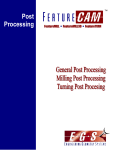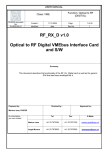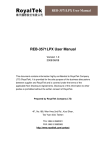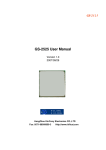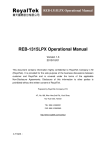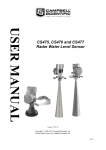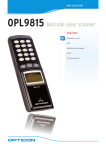Download EC1600 - ESS Earth Sciences
Transcript
EC1600 AUTO-RANGING ELECTRICAL CONDUCTIVITY SENSOR 141 Palmer Street Richmond VIC 3121 Australia T: +61 3 8420 8999 F: +61 3 8420 8900 www.essearth.com Table of Contents Quality Assurance Statement ............................................................ 2! ISO9001 accreditation ....................................................................................... 2! Terms of Warranty ............................................................................................. 2! Conductivity - An Introduction .......................................................... 3! What is electrical conductivity? .......................................................................... 3! How is conductance measured in practice? ........................................................ 3! How does the 1600 conductivity sensor work? ................................................... 4! What is temperature compensation? .................................................................. 5! Sensor description ............................................................................ 6! Installation ....................................................................................... 7! Site Selection ..................................................................................................... 7! Well-chosen sites: .............................................................................................. 7! Avoid sites with: ................................................................................................ 7! Installation Orientation ...................................................................................... 8! Sensor Clearance ................................................................................................ 8! Site preparation ................................................................................................. 9! EC1600 Electrical Connection.......................................................... 10! SDI-12 and 4-20mA connections ...................................................................... 10! 4-20mA Interface ............................................................................................. 11! SDI-12 Interface .............................................................................................. 11! Operation ....................................................................................... 12! Standard SDI-12 Commands ............................................................................ 12! EC1600-specific SDI-12 Commands .................................................................. 13! Example program to read SDI-12 ..................................................................... 14! Maintenance ................................................................................... 15! General ............................................................................................................ 15! Calibration check .............................................................................................. 15! Specifications ................................................................................. 16! Product Return Form ...................................................................... 17! 1 Quality Assurance Statement ISO9001 accreditation ESS Earth Sciences is currently an AS/NZS ISO9001:2008 certified organisation. This certification is evidence that sound practices are used to get high quality instrumentation to your organization within a reasonable time interval. Standard practices are used for all areas of manufacture, beginning with the efficient procurement of incoming orders, right through to shipment. Stringent quality assurance procedures are applied to all aspects of manufacturing, including the calibration of scientific instruments against NATA traceable references. Every sensor is accompanied by a test and calibration certificate that can be used as reference information as well as evidence of sensor accuracy. Terms of Warranty The warranty covers part or complete replacement, repair or substitution of new instrumentation that has failed in part or completely within the warranty period. While every effort has been made to supply robust and user friendly instrumentation, the warranty does not cover instruments incorrectly installed, misused or operated in conditions outside those specified. The warranty does not cover shipment costs for instrumentation, installation or removal and, under no circumstances whatsoever, indirect or consequential losses caused by the failed instrumentation. ESS Earth Sciences believes the warranty conditions to be fair and just and in accordance with standard business practices worldwide. ESS Earth Sciences reserves the right to arbitrate any warranty issues and will ensure that warranty issues are treated with the highest standards of professional conduct. At ESS Earth Sciences we believe your investment in our products and services is a good decision and we will therefore ensure all your requirements are met at all times, both now and in the future. 2 Conductivity - An Introduction What is electrical conductivity? Electrical conductivity* is a measure of how easily electrons flow through a material. For all materials, conductivity is proportional to the cross sectional area of the current path, and inversely proportional to the distance the current has to flow. Conductivity can be measured from first principles by using a conductivity cell. This is a box containing a liquid, with two plates, each of area A separated by a distance L. The first step to determining conductivity is to measure the conductance of the material, which is simply the ratio of the current to the voltage across the cell. The basic unit of conductance is the Siemen (S). We then compensate for the size of the cell to derive the specific conductivity C in S/cm. This is simply the product of measured conductance (G) and the electrode cell constant C = G x (L/A) How is conductance measured in practice? For field use, it is not practical to use two plates separated in a cell. A common method of field conductivity measurement uses a miniaturized version of the conductivity cell. Two electrodes are separated by a short distance (typically 1 cm) and a voltage is connected across them, and the current is measured (In practice, a sinusoidal voltage is used to reduce DC effects, and four electrodes rather than two are used.) The dimensions are compensated for, and the conductivity is derived a similar manner to the conductivity cell. The above method is very common, it is simple to implement, and its operation is intuitively obvious. However it has a serious drawback: To work correctly, the electrodes must be in direct contact with the liquid. This leads to corrosion of the electrodes, resulting in unstable results, long term drift, and overall low reliability in the field. 3 How does the 1600 conductivity sensor work? The 1600 EC sensor employs a different measuring technique. Instead of electrical contact probes, it uses an inductive (or magnetic) method to determine conductivity. By using this approach, there is no direct contact with the liquid. Although more difficult to implement, this toroidal method is inherently more reliable, and has very low drift compared with electrode type sensors, and will operate for many years, even in difficult environments. Two coils are placed a known distance apart. One coil has an oscillating current applied that forms a magnetic field inside the coil centre. The other coil receives the magnetic flux produced inside the transmit coil. Because of the coil arrangement, the receiving coil will only receive signal when a conductive material is placed between the coils. If water is allowed to flow through the coil centre, impurities in the form of dissolved salts will provide the necessary magnetic coupling. Note: Conductivity should not be confused with conductance, which is the inverse of the material’s resistance. Magnetic flux is concentrated in the middle of coils. Conductive water flowing through middle increases magnetic coupling between transmit and receive coils. The above diagram shows how the sensor works. Transmit (TX) coil forms a magnetic flux inside the coil pair. Conductive water increases the magnetic coupling which is seen as a transfer of oscillating current in receiver (Rx) coil. The degree of transfer is an indication of water conductivity. 4 What is temperature compensation? Like resistance, conductivity changes with temperature. The lower the temperature, the less the conductivity and this is because electrons find it harder to flow through dissociated salt molecules at lower temperature. This makes measurement confusing when actually trying to determine the water conductivity over a temperature range. To overcome this effect, conductivity measurements at any temperature are output as if the temperature is 25°C and is called temperature compensated output. The relationship between compensated and non compensated (raw) output is linear and simply put, a percentage is added or subtracted from the raw measurement to determine compensated output. For the 1600 EC sensor, the compensation is set at approximately 2% per °C. For temperatures below 25 °C the proportion is subtracted and is added for temperatures above 25°C. Of course the temperature needs to be measured for compensation and therefore the 1600 EC sensor has an internal temperature sensor. As an additional feature, the 1600 EC sensor also has a separate temperature output available to loggers and controllers as a 4-20mA signal. Temperature compensation operates between 0 and 50°C, the typical expected water temperature for most environmental conditions. 5 Sensor description 8 mm 20 mm 262 mm 56 mm The 1600 sensor is a fully submersible device used for measuring water conductivity. It is constructed from durable machined plastic components and epoxy resins. For reliability, there are no wetted metal components to corrode making this sensor suitable for high conductivity (high dissolved solids) application and even for water with high acidity. The 1600 EC sensor is designed for very long term deployment at unattended monitoring stations. The sensor head is fully epoxy encapsulated and has a hole through the middle to allow the flow of water through it. It is here that the water provides magnetic coupling for the measurement to take place. An 8mm diameter submersible rated cable is hardwired to the back of the sensor (length specified during ordering). Although care must be taken to secure the sensor at all times, the sensor may be suspended from the cable for short periods such as during installation. Once installed and powered, the sensor will measure conductivity from 0 to 100,000 µS/cm. The “dry” end of the cable has fife wires for supply, ground, SDI-12 and current output signals. Connectors can be fitted for direct connection to ESS Earth Sciences equipment (such as the 3500 logger) or custom connectors can be fitted upon request. There are no moving parts on the 1600 EC sensor, and no serviceable components. This sensor is a dual output 3 wire current loop device plus SDI-12 as detailed in the Installation section. 6 Installation Site Selection Before installing a 1600 EC sensor it is recommended a suitable site be selected first. The installation and maintenance complexity as well as the reliability of the instrument in critical applications depends on the site chosen and the length of cable required can then be determined. Well-chosen sites: • slow flowing water (no stratification) • minimal or no accumulation of debris around sensor • easy and safe access, away from waterway traffic • sensor head is always submerged in at least 200mm of water • sensor head is at least 100mm from bottom and at least 50mm from any metal • sensor cannot be dislodged during high flows Avoid sites with: • very low or stagnant water flows • where debris can accumulate inside sensor head • excessive air bubbles in water • difficult or unsafe access • high siltation rates • where sensor will be exposed in air during low flows The following is also recommended for EC sensor installation • Install the sensor out of direct sunlight, especially when in shallow water. Sunlight will heat the sensor head to produce a false temperature and compensated EC reading. • Algae will tend to grow within the sensor hole. This can be minimized by covering the sensor with a shield to make the head as dark as possible. No sunlight means no algae • Silt can accumulate in the sensor hole. Install the sensor so water can flow through the hole. Typically, most sites that are already equipped with hydrographic instrumentation can be used for installation of the 1600 EC sensor. 7 Installation Orientation For correct installation, the following recommendations apply: poly pipe >50mm >50mm flow poly pipe flow With the exception of the sensor head (the part with the hole through it), the rest of the sensor can be completely covered by an installation tube. If 50mm ID poly tube is used for installation, a suitable compression gland is available from irrigation hardware suppliers. The sensor outside diameter is smaller than the compression gland internal diameter and can be clamped easily and securely using this method. When this system is used, the sensor head must protrude from the gland by at least 60mm. Sensor Clearance Correct orientation of the sensor will help to reduce the buildup of silt and debris within the hole in the center of the EC head. Where algal blooms are likely it is recommended the sensor is covered with a sun shield, keeping the sensor in the shade, thereby reducing algae buildup. When installing a shield, ensure the shield clears the sensor head by at least 50mm. The shield should ideally be installed 100mm from the sensor, and cover the sensor sufficiently from direct sunlight. A shield will also prevent excessive temperature variations. 8 Site preparation Before the sensor can be installed, the site must be prepared to ensure the sensor will be secured, protected and serviceable. The following recommendation is based on typical installation methods practiced by today’s hydrographers. Several variations of this method are used to suit particular applications. Please study the diagram below. Site preparation involves the installation of a larger plastic tube along the waterway bank as shown. The tube should ideally be continuous but may also be made from sections. One end of the tube must be installed into the water ensuring the sensor optical path will not be obstructed according to the previous section Sensor Clearance. The other end can be terminated in a junction pit that is large enough so that the sensor can be inserted from the pit. Typically, an underground electrical pit is used as this also allows a sensor carrier assembly to be inserted easily. The pit must be installed on a stable part of the bank that cannot erode. Site shelter Junction pit Sensor tube with sensor installed at end. Detail view below waterway A waterway bank Optional guide disks Guide tube. Sensor is made from plastic Cable tie or similar devices strapped to side of tube. 9 EC1600 Electrical Connection SDI-12 and 4-20mA connections +12 volts dc (red) SDI-12 SDI I/O (green) EC out 4-20mA (blue) The EC1600 is an SDI-12 sensor plus two 3 wire current loop devices load (RL ) Common (black) load (RL ) Temp out 4-20mA (yellow) switched +12Vdc 4-20mA EC out 4-20mA temperature out SDI-12 in/out common (0V) Conductor Conductor Designation Requirement Colour Connector 5-pin red switched +12vdc input 80mA min A blue 4-20mA output, EC Source, max 120 Ohm load B black Common 0V dc C yellow 4-20mA output, Temp Source, max 120 Ohm load D green SDI-12 in/out E 10 4-20mA Interface To obtain a measurement from the 1600 sensor: • Install the sensor according to recommendations in Section Installation. • Apply power to the sensor • 2 x 4-20mA current output will be produced at the respective outputs. • Conductivity and temperature data is available on the SDI-12 bus A current output signal will be available for measurement after 1 second. For power conserving applications, the sensor can be switched off immediately after the reading is attained. The sensor can also be left on continuously if required. The 4-20mA current output will be available for reading 1 second after switched power is applied. With proper care and routine maintenance, the sensor can be left operating unattended for several months. Of course, as each application will be different, it is recommended that the total time between services is determined experimentally. SDI-12 Interface The SDI-12 interface of the EC1600 handles all of the communication and power down features of the SDI-12 protocol. All standard SDI-12 commands are supported. In addition, extended commands can be used to calibrate sensor outputs. Each of the measurements can be scaled and offset with user supplied calibration coefficients. The factory sets these parameters so the output is in µS/cm. Any changes to these parameters should take into account their factory calibration values as these have been established by measurement for each sensor. The SDI-12 Interface also has an on board temperature sensor. The interface has been fully tested with the NR Systems SDI-12 Verifier. 11 Operation Standard SDI-12 Commands The commands assume that the sensor address is 0, but any address could be substituted into the commands below. "\r\n" is carriage return and line feed characters. Command Description ?! Returns address of a single sensor on the SDI-12 bus 0! Acknowledgment, returns same address 0An! Change SDI-12 address to n (i.e. n=5) 0I! Query sensor information 0M! Begin a measurement. Then use 0D0! To display result. 0D0! Get data – use this after a 0M! Command. 5 values are being returned: EC25, EC, Temperature, Raw_EC, Raw_Temperature. 0MCD0! Measure and display as above, include a CRC (as defined in the SDI-12 standard) Symbols and Units: EC 25: Compensated conductivity at 25°C in µS/cm. EC: Conductivity in µS/cm Temperature: Temperature in ºC Raw_EC EC in ADC counts Raw_Temperature: Temperature in ADC counts The display command 0D0! produces 5 values in this sequence: id+EC25+EC+Temperature+Raw_EC+Raw_Temperature Note: The value for EC25 is always 0 at present. Example command and response: 0M! 00015 0D0! 0+00000+00774+20.51+000977+00538 0I! 013ES&S EC16000.8 160159 12 EC1600-specific SDI-12 Commands The following list shows EC1600 specific commands that have been implemented in addition to the required commands of the SDI-12 standard. Depending on the utility used, the commands need to be completed by a preceding address character (in the examples below we use 0 - zero) and terminated by an exclamation mark. For example, the command Xuptime needs to be send to the device with the address 0: 0Xuptime! Command Description SDI-12 Command General Maintenance and Setup Commands Read serial number 0Xsn! Reset device 0Xreset 1! Check uptime 0Xuptime! Status information 0Xstatus! Firmware version 0Xversion! Set SDI-12 address 0Xaddr 5 Example / comment 160161 Seconds of runtime Fix measurement range to lower range Fix measurement range to upper range Fix measurement range to auto-ranging Query 4-20mA Interface – what temperature is 4mA? Set temperature at 4mA 0Xrfix 0! In this example it sets SDI-12 address from 0 to 5. This is an alternative to the standard SDI-12 nA! command Fix range to 0 to 25000 uS/cm 0Xrfix 1! Fix range to 25000 to 100000 uS/cm 0Xrfix 255! Set range to auto (default) 0Xcte 4! 0.0 0Xcte 4 [<float>]! Query 4-20mA Interface – what temperature is 20mA? Set temperature at 20mA 0Xcte 20! Can be any floating point value from 0.0 to 50.0 50.0 0Xcte 20 [<float>]! Can be any floating point value from 0.0 to 50.0 Query 4-20mA Interface – what EC value is at 4mA? Set temperature at 4mA 0Xcec 4! 0.0 0Xcec 4 [<float>]! Can be any value from 0.0 to 100000.0 Query 4-20mA Interface – what EC value is at 20mA? Set temperature at 20mA 0Xcec 20! 100000.0 0Xcec 20 [<float>]! Can be any value from 0.0 to 100000.0 0Xm! Takes a measurement and displays the result (faster than the 2-step standard SDI12 command). Measurement commands Take a measurement The measurement command 0Xm! produces 5 values in this sequence: temp_adc temperature ec_adc ec ec25 status Vcc Example result: 0432 5.76 02359 2281.4 0.0 OK!! 11.46 r0 13 range Example program to read SDI-12 The following program can be used with the Campbell Scientific CR1000 logger. Program name: CR1000 sample display reading.CR1 'Date written: 3/06/2009 using the CRBasic programming tool from 'Campbell Scientific LoggerNet 3.4.1 'This program is used to test the SDI-12 Interface using a 'Campbell’s CR1000 logger. ' 'Sensor powered from 12V terminal and a G terminal, and with SDI-12 'on C1 terminal. 'Logger C1----green------Sensor SDI-12 ' 12V---red--------Sensor Power +ve ' G ----black------Sensor Ground 'The program below will collect data each second from the five SDI-12 'Interface channels. 'Use one of the Data Displays from the LoggerNet Connect Screen. 'Set the table cells to sdidata(1) to sdidata(5). 'The information from each of the four channels of the SDI-12 Sensor 'Engine will be displayed and updated every second. Public sdidata(5) 'sdidata(1) ec25 'Sdidata(2) ec 'Sdidata(3) temperature 'Sdidata(4) adc_conductivity 'Sdidata(5) adc_temperature BeginProg Scan(1,Sec, 3, 0) SDI12Recorder(sdidata, 1, "0", "M!", 1.000, 0) NextScan EndProg 14 Maintenance The 1600 sensor will require little periodic maintenance to ensure that measurements remain accurate. While all wetted components are no metallic and cannot corrode in high salt or acidity liquids. Debris, silt and algae lodged in the hole can cause inaccurate readings. It is recommended the sensor is checked during every visit, or at least every 3-6 months. You may find the sensor will not require any maintenance for even longer periods however, warmer climates or high silt laded rivers and streams can accelerate these effects. General • Ensure the sensor is not affected by debris, silt or algae (or marine growth). The sensor should be removed from its installed location for a thorough inspection. Using the recommended installation method outlined in the section Installation, removal should be easy and maintenance staff do not need to enter the waterway • Ensure the installation is sound and the sensor is still secure from moving and there are no obvious signs of erosion or damage. Calibration check The sensor output can be checked against a reference instrument if it is available. Ideally, the measurement should be taken in the same solution as the sensor while the sensor is installed. If there is a large difference, an installation problem may be highlighted. All sensor measurements should be within the specified accuracy. • Compare the sensor measurement to that of the reference instrument. • Ensure the reference instrument calibration error is also known. 15 Specifications Range 200 to 100,000µS/cm Accuracy EC linearity < 2% over the range 0 to 30°C Temperature < 0.2°C over the range 0 to 30°C. Temperature range -10 to 60°C storage (in dry environment), operating: 0 to 50°C Response Time 2 seconds to full accuracy Type Magnetic inductive coupling SDI-12 Output EC in µS/cm (standard) 4-20mA Output Scaled to maximum range. EC: 4mA: 0µS/cm (user adjustable) 20mA: 100,000µS/cm (user adjustable) 4mA: 0 °C (user adjustable) 20mA: 50 °C (user adjustable) Temperature: Power Supply 12VDC, current capability >500mA 0.3mAh per reading on average (typical) Surge Secondary surge protection, Can absorb 0.6J of energy Dimensions 262 long, 56 dia (mm) 8 mm 20 mm 262 mm 16 56 mm Product Return Form As part of our Quality Assurance initiative, and to improve response time, we request that the forms below are completed in as much detail as possible for product returns. OPERATOR INFORMATION Name and contact details Company Date/Time Logger Site Location of product PRODUCT INFORMATION Model Serial number S/W version number(s) H/W version number(s) SOFTWARE USED Download program Remote or Local download Other software used CONFIGURATION Logger Length of tube Last logged values Measurement interval SITE - Describe site. Is unit in protective hut or enclosure? List any other sensors which are used at the site. Estimate cable length to sensors POWER SUPPLY Battery Voltage / Capacity Internal/External Solar/Mains charger Measured battery volts Solar Panel Voltage/Capacity Regulator make / model Switching/Linear regulator Mains supply COMM PORT SDI-12 port EARTHING -Describe any special earthing arrangements in place. 17 4-20mA DESCRIPTION OF PROBLEM How did the problem manifest itself? Weather conditions while fault occurred (especially temperature) What commands were being used (SDI12 or serial)? If possible, list the exact commands used, and the sequence. List the commands sent through the logger What action was taken to get the unit going again? Have you noticed anything in common with the last time there was a fault? Was the unit permanently disabled, or is the fault intermittent? Is this the first time the fault occurred? Is there anything unusual about this site compared to other sites? Is there any other equipment or facilities (e.g. local power lines) which could cause interference? Please list any other issues relating to the site or the fault. 18 The 2600 Turbidity sensor is a miniature backscatter 141 Palmer Street Richmond VIC 3121 Australia T: +61 3 8420 8999 F: +61 3 8420 8900 www.essearth.com





















